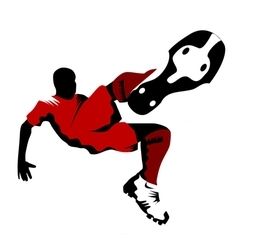The Catenaccio System

The Catenaccio or The Chain System in football is an ultra-defensive football tactic, aimed at shutting down the opposition defensively and then catching them on the break as they try their best to find a breakthrough. In Italian, the term Catenaccio means ‘door bolt’ and the system in football relies heavily on a highly organized as well as extremely effective and efficient backline of the defense that focuses mainly on nullifying the attacks of the opponents and preventing them from creating goal-scoring opportunities.
The system, largely employed by the Italian national football team, was implemented and made famous by Helenio Herrera, a manager of Franco-Argentine descent with the Italian club side Inter Milan in the 1960s to grind out results, usually 1-0, 2-0 or 2-1 wins. Herrera got his inspiration in coming up with the system from the Verrou system (meaning chain or door bolt in French) which was invented by a relatively unknown Austrian manager named Karl Rappan. When he was appointed as the manager of the Switzerland national football team in the early 1930s through to the 1940s, he employed the system and deployed a sweeper back called the Verrouilleur who played a highly defensive game and was positioned just ahead of the goalkeeper, providing additional cover for him.
When Nereo Rocca was appointed as the manager of the Italian club side Padova, he pioneered the system and it would be picked up from him by Herrera who would go on to use it successfully with the Inter Milan team of the 1960s. The Verrou system founded by Rappan was first proposed in 1932 when he was the manager of the Swiss club Servette and used four defenders, fixed to their positions, and played in an extremely strict and rigid man-marking system. The link between these four fixed defenders was a playmaker deployed in the midfield role and two wingers, who tried to create openings for the strikers when they got the chance.
The tactic, often referred to in the 1-3-3-3 format, was called the real Catenaccio and some of the variations of the system were the use of the tactical formation 1-4-3-2 or the 1-4-4-1. Perhaps the most important innovation of the system came in the form of the deployment of a libero, often called the sweeper behind the three-man defensive line, whose sole task was to recover and clear the loose balls, nullifying the attacks of the opposition if they penetrated the defensive line as well as provide cover for a defender while man-marking. The counter-attacking system, based on the long passes from the defense was another important innovation of the system.
Herrera used 5 defenders in his version, with four of the defenders man-marking the front 4 of the opposition side and the libero was used for further protection. This defensive approach won Inter Milan the European Cup in 1964 and 1965 as well as the FIFA World Cup for Italy in 1982, when they beat much-fancied oppositions to the title.
